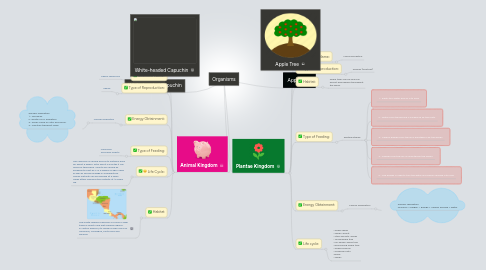
1. White-headed Capuchin
2. Animal Kingdom
2.1. Scientific Name:
2.1.1. Cebus capucinus
2.2. Type of Reproduction:
2.2.1. Sexual
2.3. Energy Obtainment:
2.3.1. Celullar respiration
2.3.1.1. Aerobic respiration. 1.- Glycoysis. 2.-Acetyl Co-A formation. 3.- Krebs Cycle or critic acid cycle. 4.- Electron transport chain
2.4. Type of Feeding:
2.4.1. Omnivore. Food and insects
2.5. Life Cycle:
2.5.1. The capuchin is carried across its mother's back for about 6 weeks. After about 3 months it can move by themselve. Infants are carried by alloparents most by 4 or 6 weeks of age. Males as well as Female engage in alloparenting. Sexual maturity can be reached at 3 years. Males attain reproductive maturity at 10 years old.
2.6. Habitat
2.6.1. The White-headed Capuchin is found in high tropical forests and wet lowland regions. In central america, its range include much of Honduras, Nicaragua, Costa Rica and Panama.
3. White-headed Capuchin
4. Apple Tree
5. Plantae Kingdom
5.1. Scientific Name:
5.1.1. Malus Domestica
5.2. Type of Reproduction:
5.2.1. Asexual (Grafting)
5.3. Habitat:
5.3.1. Apple trees can be found in almost everywhere throughout the world.
5.4. Type of Feeding:
5.4.1. Photosynthesis
5.4.1.1. 1.- Plants turn water and air into food.
5.4.1.2. 2.- Water from the ground is sucked up by the roots.
5.4.1.3. 3.- Carbon dioxide from the air is breathed in by the leaves.
5.4.1.4. 4.- Energy from the sun is collected by the leaves.
5.4.1.5. 5.- The energy is used to turn the water and carbon dioxide into food.
5.5. Energy Obtainment:
5.5.1. Celullar Respiration
5.5.1.1. Aerobic respiration. Glucose + Oxygen = Energy + Carbon Dioxide + Water
5.6. Life cycle:
5.6.1. - Apple seeds - Seeds' sprout - Stem sprouts' leaves - Young apple tree - Full grown Apple tree - Blossoming Apple tree - Apple blossom - Growing Fruits -Apple - Seeds

